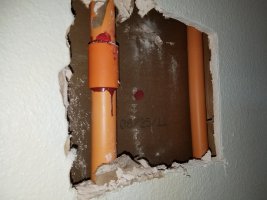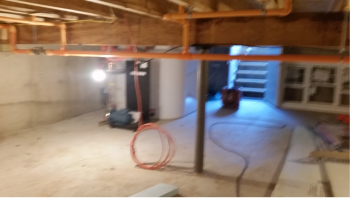TheCommish
Registered User
The conditions;
Massachusetts, residential NFPA 13D-13 sprinkler system, Spears FlameGuard CPVC piping, in a crawl space approx. 5 feet from the floor to the underside of the I joists, without fuel-fired equipment.
Piping is proposed to be installed without sprinkler heads in the crawl space and with any sheetrock or other protective material over the piping.
Manufacture instructions; when used with standard response sprinklers, protections shall be provided… by ceiling walls or soffits…
Alternate to the protection requirements piping can be installed without protection subject to the following additional limitations; exposed piping is installed below smooth flat surface, listed Quick response heads, 8 inches from the ceiling.
Basement unfinished CPVC sprinkler product can be installed without protection with 2x10 floor joist 16 inches on center, or I joist up to 11 7/8 up to 24 inches on center, residential pendant sprinklers 155deg 4.9 K factor
The install contractor, factor rep, and contractor say it is allowed to install the unprotected pipe in the crawl space, this space in my opinion is not a concealed space, it has outside access to the space for servicing the water tanks and pump for the 13D system.
The manufactures literature talks about protecting the piping with covering or specific requirements for exposed piping and sprinkler heads.
The question, am I missing something? I do not see where there is a manufacture’s listing or installation allowance for a crawl space the CPVC piping to be installed unprotected in the crawl space.
Massachusetts, residential NFPA 13D-13 sprinkler system, Spears FlameGuard CPVC piping, in a crawl space approx. 5 feet from the floor to the underside of the I joists, without fuel-fired equipment.
Piping is proposed to be installed without sprinkler heads in the crawl space and with any sheetrock or other protective material over the piping.
Manufacture instructions; when used with standard response sprinklers, protections shall be provided… by ceiling walls or soffits…
Alternate to the protection requirements piping can be installed without protection subject to the following additional limitations; exposed piping is installed below smooth flat surface, listed Quick response heads, 8 inches from the ceiling.
Basement unfinished CPVC sprinkler product can be installed without protection with 2x10 floor joist 16 inches on center, or I joist up to 11 7/8 up to 24 inches on center, residential pendant sprinklers 155deg 4.9 K factor
The install contractor, factor rep, and contractor say it is allowed to install the unprotected pipe in the crawl space, this space in my opinion is not a concealed space, it has outside access to the space for servicing the water tanks and pump for the 13D system.
The manufactures literature talks about protecting the piping with covering or specific requirements for exposed piping and sprinkler heads.
The question, am I missing something? I do not see where there is a manufacture’s listing or installation allowance for a crawl space the CPVC piping to be installed unprotected in the crawl space.


